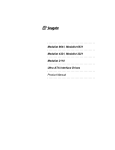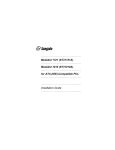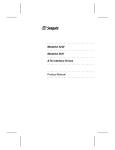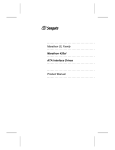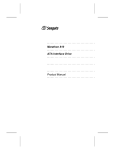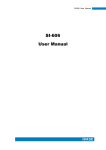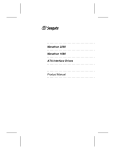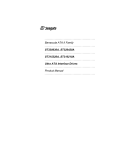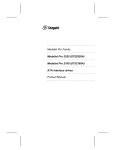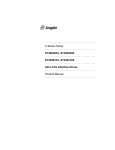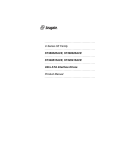Download Seagate Medalist 2120 Product manual
Transcript
..................................... Medalist 4340, Medalist 3230 ..................................... Medalist 2120, Medalist 1721 ..................................... Medalist 1010 ..................................... ATA Interface Drives ..................................... Product Manual ..................................... ..................................... Medalist 4340, Medalist 3230 ..................................... Medalist 2120, Medalist 1721 ..................................... Medalist 1010 ..................................... ATA Interface Drives ..................................... Product Manual ..................................... 1997 Seagate Technology, Inc. All rights reserved Publication Number: 20400054-001, Rev. A, July 1997 Seagate, Seagate Technology, the Seagate logo, Medalist and the Medalist logo are registered trademarks of Seagate Technology, Inc. Other product names are registered trademarks or trademarks of their owners. Seagate reserves the right to change, without notice, product offerings or specifications. No part of this publication may be reproduced in any form without written permission from Seagate Technology, Inc. Medalist 4340, 3230, 2120, 1721 and 1010, Rev. A iii Contents Introduction . . . . . . . . . . . . . . . . . . . . . . . . . . . . 1 Specification summary table . . . . . . . . . . . . . . . . . . . 2 1.0 Drive specifications . . . . . . . . . . . . . . . . . . . . . . 5 1.1 Formatted capacity . . . . . . . . . . . . . . . . . . . . . 5 1.1.1 Default logical geometry . . . . . . . . . . . . . . . . 5 1.1.2 Supported CHS translation geometries . . . . . . . . 6 1.2 Physical organization . . . . . . . . . . . . . . . . . . . . 6 1.3 Recording and interface technology . . . . . . . . . . . . . 6 1.4 Physical characteristics . . . . . . . . . . . . . . . . . . . 7 1.5 Seek time . . . . . . . . . . . . . . . . . . . . . . . . . . 7 1.6 Start/stop times . . . . . . . . . . . . . . . . . . . . . . . 8 1.7 Power Specifications . . . . . . . . . . . . . . . . . . . . 8 1.7.1 Power consumption . . . . . . . . . . . . . . . . . . 8 1.7.2 Conducted noise . . . . . . . . . . . . . . . . . . . . 11 1.7.3 Voltage tolerance . . . . . . . . . . . . . . . . . . . . 11 1.7.4 Power-management modes . . . . . . . . . . . . . . 11 1.8 Environmental tolerances . . . . . . . . . . . . . . . . . . 12 1.8.1 Ambient temperature . . . . . . . . . . . . . . . . . . 12 1.8.2 Temperature gradient . . . . . . . . . . . . . . . . . 12 1.8.3 Humidity . . . . . . . . . . . . . . . . . . . . . . . . 12 1.8.4 Altitude . . . . . . . . . . . . . . . . . . . . . . . . . 13 1.8.5 Shock . . . . . . . . . . . . . . . . . . . . . . . . . . 13 1.8.6 Vibration . . . . . . . . . . . . . . . . . . . . . . . . 13 1.9 Drive acoustics . . . . . . . . . . . . . . . . . . . . . . . 14 1.10 Electromagnetic susceptibility . . . . . . . . . . . . . . . 14 1.11 Reliability . . . . . . . . . . . . . . . . . . . . . . . . . . 14 1.12 Agency certification . . . . . . . . . . . . . . . . . . . . 15 1.12.1 Safety certification . . . . . . . . . . . . . . . . . . 15 iv Medalist 4340, 3230, 2120, 1721 and 1010, Rev. A 1.12.2 Electromagnetic Compatibility . . . . . . . . . . . . 15 1.12.3 FCC verification . . . . . . . . . . . . . . . . . . . . 15 2.0 Drive mounting and configuration . . . . . . . . . . . . . . 17 2.1 Handling and static-discharge precautions . . . . . . . . . 17 2.2 Jumper settings . . . . . . . . . . . . . . . . . . . . . . . 17 2.2.1 Master/slave configuration . . . . . . . . . . . . . . . 17 2.2.2 Alternate capacity jumper 2.3 Drive mounting . . . . . . . . . . . . . . . 17 . . . . . . . . . . . . . . . . . . . . . . . 18 3.0 ATA interface . . . . . . . . . . . . . . . . . . . . . . . . . 21 3.1 ATA interface signals and connector pins . . . . . . . . . . 21 3.2 ATA Interface commands . . . . . . . . . . . . . . . . . . 23 3.2.1 Supported ATA commands . . . . . . . . . . . . . . . 23 3.2.2 Identify Drive command . . . . . . . . . . . . . . . . 25 3.2.3 Set Features command . . . . . . . . . . . . . . . . 29 3.2.4 S.M.A.R.T. commands . . . . . . . . . . . . . . . . . 30 Medalist 4340, 3230, 2120, 1721 and 1010, Rev. A v Figures Figure 1. Typical startup and operation current profile for the ST34340A and ST33230A . . . . . . . . . . . . . . . . 10 Figure 2. Typical startup and operation current profile for the ST32120A, ST31721A and ST31010A . . . . . . . . . . 10 Figure 3. Alternate capacity jumper and master/slave jumpers . . 18 Figure 4. Mounting dimensions—top, side and end view . . . . . . 19 Figure 5. I/O pins and supported ATA signals . . . . . . . . . . . 22 vi Medalist 4340, 3230, 2120, 1721 and 1010, Rev. A Medalist 4340, 3230, 2120, 1721 and 1010, Rev. A 1 Introduction The Medalist 4340 (ST34340A), Medalist 3230 (ST33230A), Medalist 2120 (ST32120A), Medalist 1721 (ST31721A) and Medalist 1010 (ST31010A) provide the following key features: • Low power consumption • Quiet operation • Support for S.M.A.R.T. drive monitoring and reporting • High instantaneous (burst) data-transfer rates (up to 16.7 Mbytes per second) using PIO mode 4 and DMA mode 2 • Full-track multisector transfer capability without local processor intervention • 128-Kbyte adaptive multisegmented cache • State-of-the-art caching and on-the-fly error-correction algorithms • Support for Read/Write Multiple commands • Support for autodetection of master/slave drives that use cable select (CSEL) 2 Medalist 4340, 3230, 2120, 1721 and 1010, Rev. A Specification summary table The specifications listed in this table are for quick reference. For details on specification measurement or definition, see the appropriate section of this manual. Drive Specification ST34340A ST33230A ST32120A ST31721A ST31010A Guaranteed Mbytes (×106 bytes) 4,303 3,227 2,111 1,704 1,082 Guaranteed sectors 8,404,830 6,303,024 4,124,736 3,329,424 2,114,784 Bytes per sector 512 Default sectors per track 63 Default read/write heads 15 16 16 16 16 Default cylinders 8,894 6,253 4,092 3,303 2,098 Physical read/write heads 8 6 4 4 2 Discs 4 3 2 2 1 Recording density (bits/inch max) 115,100 Track density (tracks/inch) 5,950 Areal density (Mbits/inch2) 685 Spindle speed (RPM) 4,500 Internal data-transfer rate (Mbits/sec max) 87.8 I/O data-transfer rate (Mbytes/sec max) 16.7 ATA data-transfer modes supported PIO modes 0, 1, 2, 3, 4; Multiword DMA modes 0, 1, 2 Cache buffer (Kbytes) 128 Height (mm max) 26.2 Width (mm max) 102.4 Length (mm max) 146.8 Medalist 4340, 3230, 2120, 1721 and 1010, Rev. A Drive Specification Weight (grams typical) 3 ST34340A ST33230A ST32120A ST31721A ST31010A 540 510 Track-to-track seek time (msec typical) 2 (seek), 2.5 (read), 3.5 (write) Average seek time (msec typical) 12 (seek), 12.5 (read), 14.5 (write) Full-stroke seek time (msec typical) 21.5 (seek), 22.0 (read), 23.0 (write) Average latency (msec) 6.67 Power-on to ready (sec typical) 14 Standby to ready (sec typical) 10 Startup current: 12V (peak) 5V (RMS) 1.8 amps 0.675 amps 1.5 amps 0.6 amps Seek power (typical) 6.8 watts 5.6 watts Operating power (typical) 5.2 watts 4.2 watts Idle mode power (typical) 4.8 watts 3.8 watts Standby mode power (typical) 1.0 watts Sleep mode power (typical) 0.7 watts Voltage tolerance (including noise) ± 5% +5V ± 10% +12V Ambient temperature (°C) 5 to 55 (op.), –40 to 60 (nonop.) Temperature gradient (°C per hour max) 20 Relative humidity (op. and nonop.) 8% to 80% Relative humidity gradient 10% per hour max 500 4 Drive Specification Wet bulb temperature (°C max) Altitude (meters above mean sea level, max) Medalist 4340, 3230, 2120, 1721 and 1010, Rev. A ST34340A ST33230A ST32120A ST31721A ST31010A 28.9 (op.), 28.9 (nonop.) –61 to 3,048 (op.) –61 to 12,192 (nonop.) Shock, operating (Gs max at 11 msec) 5 Shock, nonoperating (Gs max at 11 msec) 75 Vibration, operating 0.50 G (0 to peak, 5–350 Hz) Vibration, nonoperating 5.0 Gs (0 to peak, 5-350 Hz) Drive acoustics (bels—sound power) Idle mode (dBA— sound pressure) 3.7 (typical), 4.1 (max) 34 (typical) Drive acoustics (bels—sound power) Read/Write mode 4.3 (typical), 4.6 (max) Nonrecoverable read errors Mean time between failures (power-on hours) Contact start-stop cycles (25°C, 40% relative humidity) Service life (years) 1 per 1014 bits read 300,000 40,000 5 Medalist 4340, 3230, 2120, 1721 and 1010, Rev. A 5 1.0 Drive specifications Unless otherwise noted, all specifications are measured under ambient conditions, at 25°C, and nominal power. For convenience, the phrases the drive and this drive are used throughout this manual to indicate the ST34340A, ST33230A, ST32120A, ST31721A and the ST31010A. 1.1 Formatted capacity Guaranteed Mbytes (1 Mbyte = 106 bytes) Guaranteed sectors (n) Bytes per sector ST34340A 4,303 8,404,830 512 ST33230A 3,227 6,303,024 512 ST32120A 2,111 4,124,736 512 ST31721A 1,704 3,329,424 512 ST31010A 1,082 2,114,784 512 Drive Model Note. DOS systems cannot access more than 528 Mbytes on a drive unless 1) the host system supports and is configured for LBA addressing or for extended CHS addressing, 2) the host system contains a specialized drive controller, or 3) the host system runs BIOS translation software. Contact your Seagate® representative for details. 1.1.1 Default logical geometry CHS Mode Cylinders Read/Write heads Sectors per track ST34340A 8,894 15 63 ST33230A 6,253 16 63 ST32120A 4,092 16 63 ST31721A 3,303 16 63 ST31010A 2,098 16 63 LBA Mode When addressing your drive in LBA mode, all blocks (sectors) are consecutively numbered from 0 to n – 1, where n is the number of guaranteed sectors as defined in the table above. 6 Medalist 4340, 3230, 2120, 1721 and 1010, Rev. A 1.1.2 Supported CHS translation geometries These drives support any translation geometry that satisfies all of the following conditions: Drive Model (sectors per track) × (read/write heads) × (cylinders) Sectors Read/Write per track heads ST34340A ≤ 63 ≤ 15 ≤ 8,404,830 ST33230A ≤ 63 ≤ 16 ≤ 6,303,024 ST32120A ≤ 63 ≤ 16 ≤ 4,124,736 ST31721A ≤ 63 ≤ 16 ≤ 3,329,424 ST31010A ≤ 63 ≤ 16 ≤ 2,114,784 1.2 Physical organization Drive Model Read/Write heads Number of Discs ST34340A 8 4 ST33230A 6 3 ST32120A 4 2 ST31721A 4 2 ST31010A 2 1 1.3 Recording and interface technology Interface ATA Recording method 2/3 (1,7) RLL Recording density (bits/inch) 115,100 Track density (tracks/inch) 5,950 2 Areal density (Mbits/inch ) 685 Spindle speed (RPM) ( ± 0.5%) 4,500 Medalist 4340, 3230, 2120, 1721 and 1010, Rev. A 7 Internal data-transfer rate (Mbits per second max) 87.8 I/O data-transfer rate (Mbytes per second max) 16.7 (PIO mode 4 with IORDY) 16.7 (multiword DMA mode 2) Interleave 1:1 Cache buffer (Kbytes) 128 1.4 Physical characteristics ST34340A ST33230A ST32120A ST31721A Maximum height (mm) (inches) 26.2 1.03 Maximum width (mm) (inches) 102.4 4.03 Maximum length (mm) (inches) 146.8 5.78 Typical weight (grams) (ounces) 540 19.04 510 17.98 ST31010A 500 17.68 1.5 Seek time All seek times are measured using a 486 AT computer (or faster) with a 8.3 MHz I/O bus. The measurements are taken with nominal power at 25°C ambient temperature. All times are measured using drive diagnostics. The specifications in the table on page 8 are defined as follows: • Track-to-track seek time is an average of all possible single-track seeks in both directions. • Average seek time is a true statistical random average of at least 5,000 measurements of seeks between random tracks, less overhead. • Full-stroke seek time is one-half the time needed to seek from the first data cylinder to the maximum data cylinder and back to the first data cylinder. The full-stroke typical value is determined by averaging 100 full-stroke seeks in both directions. 8 Medalist 4340, 3230, 2120, 1721 and 1010, Rev. A Seek type Seek Read Write (msec, typ.) (msec, typ.) (msec, typ.) Track-to-track 2.0 2.5 3.5 Average 12.0 12.5 14.5 Full-stroke 21.5 22.0 23.0 Average latency: 6.67 msec Note. These drives are designed to consistently meet the seek times represented in this manual. Physical seeks, regardless of mode (such as track-to-track and average) are expected to meet or exceed the noted values. Due to the manner in which these drives are formatted, however, benchmark tests that include command overhead or measure logical seeks may produce results that vary from these specifications. 1.6 Start/stop times Power-on to Ready (sec) 14 (typical) Standby to Ready (sec) 10 (typical) Ready to spindle stop (sec) 8 (typical) 1.7 Power Specifications The drive receives DC power (+5V or +12V) through a four-pin standard drive power connector. 1.7.1 Power consumption Power requirements for the drives are listed in the table on page 9. Typical power measurements are based on an average of drives tested under nominal conditions, using 5.0V input voltage at 25°C ambient temperature. Spinup power is measured from the time of power-on to the time that the drive spindle reaches operating speed. During seek mode, the read/write actuator arm moves toward a specific position on the disc surface before executing a read or write operation. Servo electronics are active. Seek mode power is measured through the drive’s serial port while the drive executes a series of sequential seeks. Read/Write power and current are measured with the heads on track, based on a 16-sector write followed by a 32-msec delay, then a 16-sector read followed by a 32-msec delay. Medalist 4340, 3230, 2120, 1721 and 1010, Rev. A 9 Operating power and current are measured using 40% random seeks, 40% read/write mode (1 write for each 10 reads), and 20% drive inactive. Idle mode power is measured with the drive up to speed, servo electronics are active, and the heads are left in a random track location. During Standby mode, the drive accepts commands, but the drive is not spinning, and the servo and read/write electronics are in power-down mode. Models ST34340A and ST33230A Mode Typical Watts (RMS) Typical Amps (RMS) 5V 12V Spinup 0.675 1.8 (Peak) Seek 6.8 (Random, no read/write) 0.40 0.40 Read/Write 4.9 0.45 0.22 Operating 5.2 0.47 0.24 Idle 4.8 0.41 0.23 Standby 1.0 0.20 — Sleep 0.7 0.14 — Models ST32120A, ST31721A and ST31010A Mode Typical Watts (RMS) Typical Amps (RMS) 5V 12V Spinup 0.6 1.5 (Peak) Seek 5.6 (Random, no read/write) 0.37 0.31 Read/Write 3.9 0.40 0.16 Operating 4.2 0.41 0.18 Idle 3.8 0.38 0.16 Standby 1.0 0.20 — Sleep 0.7 0.14 — 10 Medalist 4340, 3230, 2120, 1721 and 1010, Rev. A 1.7.1.1 Typical current profile Figures 1 and 2 show typical current profiles. Current (mA) 1800 1600 1400 1200 1000 800 600 400 200 0 0 1 2 3 4 5 6 7 8 9 Time (seconds) Figure 1. Typical startup and operation current profile for the ST34340A and ST33230A Current (mA) 1400 1200 1000 800 600 400 200 0 0 1 2 3 4 5 6 7 Time (seconds) Figure 2. Typical startup and operation current profile for the ST32120A, ST31721A and ST31010A 8 9 Medalist 4340, 3230, 2120, 1721 and 1010, Rev. A 1.7.2 11 Conducted noise Input noise ripple is measured at the host system power supply across an equivalent 80-ohm resistive load on the +12 volt line or an equivalent 15-ohm resistive load on the +5 volt line. • Using 12-volt power, the drive is expected to operate with a maximum of 120 mV peak-to-peak triangular-wave injected noise at up to 25 MHz. • Using 5-volt power, the drive is expected to operate with a maximum of 100 mV peak-to-peak triangular-wave injected noise at up to 25 MHz. Note. Equivalent resistance is calculated by dividing the nominal voltage by the typical RMS read/write current. 1.7.3 Voltage tolerance Voltage tolerance (including noise): 5V ± 5%, 12V ± 10% 1.7.4 Power-management modes These drives provide programmable power management to provide greater energy efficiency. In most systems, you can control power management through the system setup program. These Seagate drives feature several power-management modes, which are summarized in the following table and described in more detail below: Mode Heads Spindle Buffer Active Moving Rotating Enabled Idle Moving Rotating Enabled Standby Parked Stopped Enabled Sleep Parked Stopped Disabled Active mode. The drive is in Active mode during the read/write and seek operations. Idle mode. The spindle remains up to speed. The buffer remains enabled, and the drive accepts all commands and returns to Active mode any time disc access is necessary. Standby mode. The drive enters Standby mode when the host sends a Standby Immediate command. If the host has set the standby timer, the drive can also enter Standby mode automatically after the drive has been inactive for a specifiable length of time. In Standby mode, the buffer remains 12 Medalist 4340, 3230, 2120, 1721 and 1010, Rev. A enabled, the heads are parked and the spindle is at rest. The drive accepts all commands and returns to Active mode any time disc access is necessary. Sleep mode. The drive enters Sleep mode after receiving a Sleep Immediate command from the host. The heads are parked and the spindle is at rest. The drive leaves Sleep mode after it receives a Hard Reset or Soft Reset command from the host. After receiving the reset, the drive exits Sleep mode and enters Idle mode with all current emulation and translation parameters intact. Standby timer. Each time the drive performs an Active function (read, write or seek), the standby timer is reinitialized and begins counting down from its specified delay times to zero. If the standby timer reaches zero before any drive activity is required, the drive makes a transition to Standby mode. In both Idle and Standby mode, the drive accepts all commands and returns to Active mode when disc access is necessary. 1.8 Environmental tolerances 1.8.1 Ambient temperature Operating 5° to 55°C (41° to 131°F) Nonoperating –40° to 60°C (–40° to 140°F) Note. Above 1,000 feet (305 meters), the maximum temperature is derated linearly to 112 °F (44°C) at 10,000 feet (3,048 meters). Operating ambient temperature is defined as the temperature of the environment immediately surrounding the drive. 1.8.2 Temperature gradient Operating 20°C/hr (36°F/hr) max, without condensation Nonoperating 20°C/hr (36°F/hr) max, without condensation 1.8.3 Humidity 1.8.3.1 Relative Humidity Operating 8% to 80% noncondensing (10% per hour max) Nonoperating 8% to 80% noncondensing (10% per hour max) Medalist 4340, 3230, 2120, 1721 and 1010, Rev. A 1.8.3.2 Wet bulb temperature Operating 28.9°C (84°F) max Nonoperating 28.9°C (84°F) max 1.8.4 Altitude Operating –61 m to 3,048 m (–200 ft to +10,000 ft) Nonoperating –61 m to 12,192 m (–200 ft to +40,000 ft) 1.8.5 13 Shock All shock specifications assume that the drive is mounted securely with the input shock applied at the drive mounting screws. Shock may be applied in the X, Y or Z axis. 1.8.5.1 Operating shock These drives comply with the performance levels specified in this document when subjected to a maximum operating shock of 5.0 Gs (based on half-sine shock pulses of 11 msec, as specified in MIL-STD-202F). Shocks are not to be repeated more than two times per second. 1.8.5.2 Nonoperating shock The nonoperating shock level that the drive can experience without incurring physical damage or degradation in performance when subsequently put into operation is 75 Gs (based on nonrepetitive half-sine shock pulses of 11 msec duration, as defined in MIL-STD-202F). 1.8.6 Vibration All vibration specifications assume that the drive is mounted securely with the input vibration applied at the drive mounting screws. Vibration may be applied in the X, Y or Z axis. 1.8.6.1 Operating vibration The following lists the maximum vibration levels that the drive may experience while meeting the performance standards specified in this document. 5–350 Hz 0.50 Gs acceleration (zero to peak) 14 1.8.6.2 Medalist 4340, 3230, 2120, 1721 and 1010, Rev. A Nonoperating vibration The following lists the maximum nonoperating vibration that the drive may experience without incurring physical damage or degradation in performance when subsequently put into operation. 5–350 Hz 5.0 Gs acceleration (zero to peak) 1.9 Drive acoustics Drive acoustics are measured as overall A-weighted acoustic sound power levels (no pure tones). All measurements are generally consistent with ISO document 7779. Sound power measurements are taken under essentially free-field conditions over a reflecting plane. For all tests, the drive is oriented with the cover facing upward. Mode Typical sound power (bels) Maximum sound power (bels) Idle 3.7 4.1 Read/Write 4.3 4.6 1.10 Electromagnetic susceptibility The drive operates without errors when subjected to the following: Radiated noise* ≤ 3 volt/meter, 30 Hz to 1 GHz Electrostatic discharge* ≤ 10 KVolts Magnetic field strength ≤ 5 Gauss * Electrostatic discharge and radiated noise susceptibility are measured with the drive mounted in a representative computer system (mounted to a ground plane with earth grounding). Discharges are applied to the bezel or other external surfaces on the ground plane. 1.11 Reliability Nonrecoverable read errors 1 per 1014 bits read, max Mean time between failures 300,000 power-on hours (nominal power, 25°C ambient temperature) Medalist 4340, 3230, 2120, 1721 and 1010, Rev. A 15 Contact start-stop cycles 40,000 cycles (at nominal voltage and temperature, with 60 cycles per hour and a 50% duty cycle) Preventive maintenance None required 1.12 Agency certification 1.12.1 Safety certification The drives are recognized in accordance with UL 1950 and CSA C22.2 (950) and meet all applicable sections of IEC950 and EN 60950 as tested by TUV North America. 1.12.2 Electromagnetic Compatibility Hard drives that display the CE marking comply with European Union requirements specified in Electromagnetic Compatibility Directives. Testing is performed to standards EN50082-1 and EN55022-B. Seagate uses an independent laboratory to confirm compliance with the EC directives specified in the previous paragraph. Drives are tested in representative end-user systems. Although CE-marked Seagate drives comply with the directives when used in the test systems, we cannot guarantee that all systems will comply with the directives. The drive is designed for operation inside a properly designed enclosure, with properly shielded I/O cable (if necessary) and terminators on all unused I/O ports. Computer manufacturers and system integrators should confirm EMC compliance and provide CE marking for their products. 1.12.3 FCC verification These drives are intended to be contained solely within a personal computer or similar enclosure (not attached as an external device). As such, each drive is considered to be a subassembly even when it is individually marketed to the customer. As a subassembly, no Federal Communications Commission verification or certification of the device is required. Seagate Technology, Inc. has tested this device in enclosures as described above to ensure that the total assembly (enclosure, disc drive, motherboard, power supply, etc.) does comply with the limits for a Class B computing device, pursuant to Subpart J, Part 15 of the FCC rules. Operation with noncertified assemblies is likely to result in interference to radio and television reception. 16 Medalist 4340, 3230, 2120, 1721 and 1010, Rev. A Radio and Television Interference. This equipment generates and uses radio frequency energy and if not installed and used in strict accordance with the manufacturer’s instructions, may cause interference to radio and television reception. This equipment is designed to provide reasonable protection against such interference in a residential installation. However, there is no guarantee that interference will not occur in a particular installation. If this equipment does cause interference to radio or television, which can be determined by turning the equipment on and off, you are encouraged to try one or more of the following corrective measures: • Reorient the receiving antenna. • Move the device to one side or the other of the radio or TV. • Move the device farther away from the radio or TV. • Plug the computer into a different outlet so that the receiver and computer are on different branch outlets. If necessary, you should consult your dealer or an experienced radio/television technician for additional suggestions. You may find helpful the following booklet prepared by the Federal Communications Commission: How to Identify and Resolve Radio-Television Interference Problems. This booklet is available from the Superintendent of Documents, U.S. Government Printing Office, Washington, DC 20402. Refer to publication number 004-000-00345-4. Medalist 4340, 3230, 2120, 1721 and 1010, Rev. A 17 2.0 Drive mounting and configuration 2.1 Handling and static-discharge precautions After unpacking, and before installation, the drive may be exposed to potential handling and electrostatic discharge (ESD) hazards. Observe standard static-discharge precautions. A grounded wrist-strap is preferred. Handle the drive only by the sides of the head/disc assembly. Avoid contact with the printed circuit board, all electronic components and the interface connector. Do not apply pressure to the top cover of the drive. Always rest the drive on a padded antistatic surface until you mount it in the host system. 2.2 Jumper settings 2.2.1 Master/slave configuration You must establish a master/slave relationship between two drives that are attached to a single AT bus. You can configure a drive to be a master or slave by setting the master/slave jumpers, shown in Figure 2 on page 18. These drives support master/slave configuration using the cable select option. This requires a special daisy-chain cable that grounds pin 28 (CSEL) on one of its two drive connectors. If you attach the drive to the grounded CSEL connector, it becomes a master. If you attach the drive to the ungrounded CSEL connector, it becomes a slave. To use this option, the host system and both drives must support cable select, and both drives must be configured for cable select. To configure this drive for cable select, install a jumper as shown in Figure 2. For the master drive to recognize the slave drive using the DASP– signal, the slave drive must assert the DASP– signal at power up, and the master drive must monitor DASP– at power up. 2.2.2 Alternate capacity jumper Some older computers may “hang” if their BIOS detects a hard drive that has more than 4,092 cylinders at startup. To allow these computers to recognize the ST34340A or the ST33230A, these drives include a capacity-limiting jumper, which sets the drive’s default translation geometry to 4,092 cylinders. This limits the drive’s capacity to 2.1 Gbytes, unless third-party software is used. The alternate-capacity jumper does not exist on the ST32120A, ST31721A or the ST31010A. Medalist 4340, 3230, 2120, 1721 and 1010, Rev. A 1 2 3 4 18 2 4 1 3 pin 1 Alternate capacity jumper 4-pin power connector Master/slave jumper settings Full capacity (as shipped) Limit capacity to 2.1 Gbytes (4,092 cylinders)1 1. Use this jumper setting if your computer fails to boot because it cannot address drives with more than 4,092 cylinders. ATA interface connector 2 4 6 1 3 5 Drive is slave Drive is master in singleor dual-drive system Drive is master with non-ATA-compatible slave2 Enable cable select3 2. Use this jumper setting only if the drive does not work with a single jumper on pins 5 and 6. 3. Consult your computer manual to determine whether your computer supports cable select Figure 3. Alternate capacity jumper (ST34340A and ST33230A only) and master/slave jumpers 2.3 Drive mounting You can mount the drive in any orientation using four screws in the side-mounting holes or four screws in the bottom-mounting holes. See Figure 3 on page 19 for drive mounting dimensions. Important mounting precautions: • Allow a minimum clearance of 0.030 inches (0.76 mm) around the entire perimeter of the drive for cooling. • Use only 6x32 UNC mounting screws. • Do not insert the mounting screws more than 0.25 inches (6.25 mm) into the mounting holes. • Do not overtighten the mounting screws (maximum torque: 3 inch-lb). • Do not use a drive interface cable that is more than 18 inches long. Medalist 4340, 3230, 2120, 1721 and 1010, Rev. A Note: Units are in inches (mm) Tolerances: 0.xx ± 0.01 0.xxx ± 0.005 0.230 ± 0.015 (5.84 ± 0.38) 1.00 ± 0.03 (25.4 ± 0.8) 19 0.180 ± 0.015 (4.57 ± 0.38) 2.23 ± 0.03 (56.6 ± 0.8) 3X 6-32 UNC-2B max. insertion depth 0.14 (3.6) both sides 3.72 ± 0.03 (94.5 ± 0.8) 4X 6-32 UNC-2B max. insertion depth 0.22 (5.6) 4.000 ± 0.010 (101.60 ± 0.25) 1.750 ± 0.010 (44.45 ± 0.25) 5.75 ± 0.03 (146.1 ± 0.8) 2.362 ± 0.010 (59.99 ± 0.25) 2.375 +0.030, –0.005 (60.33 +0.76, –0.13) 3X.250 ± 0.015 (6.35 ± 0.38) (both sides) 0.630 +0.030, –0.005 (16.00 +0.76, –0.13) 3.750 ± 0.010 (95.25 ± 0.25) 4.00 ± 0.02 (101.6 ± 0.5) 0.125 +0.030, –0.005 (3.18 +0.76, –0.13) Figure 4. Mounting dimensions—top, side and end view 20 Medalist 4340, 3230, 2120, 1721 and 1010, Rev. A Medalist 4340, 3230, 2120, 1721 and 1010, Rev. A 21 3.0 ATA interface These drives use the industry-standard ATA task file interface. It supports both 8-bit and 16-bit data transfers. It supports ATA programmed input/output (PIO) modes 0, 1, 2, 3 and 4; and ATA multiword DMA modes 0, 1 and 2. The drive also supports the use of the IORDY signal to provide reliable high-speed data transfers. You can use a daisy-chain cable to connect two drives to a single AT host bus. For detailed information regarding the ATA interface, refer to the Draft ATA-3 document X3T10 2008, subsequently referred to as the Draft Proposed ATA-3 Standard. 3.1 ATA interface signals and connector pins Figure 4 on page 22 summarizes the signals on the ATA interface connector that the drive supports. For a detailed description of these signals, refer to the Draft Proposed ATA-3 Standard. 22 Medalist 4340, 3230, 2120, 1721 and 1010, Rev. A Drive pin # 1 2 3 4 5 6 7 8 9 10 11 12 13 14 15 16 17 18 19 20 21 22 23 24 25 26 27 28 29 30 31 32 33 34 35 36 37 38 39 40 Signal name Reset– Ground DD7 DD8 DD6 DD9 DD5 DD10 DD4 DD11 DD3 DD12 DD2 DD13 DD1 DD14 DD0 DD15 Ground (removed) DMARQ Ground DIOW– Ground DIOR– Ground IORDY CSEL DMACK– Ground INTRQ IOCS16– DA1 PDIAG– DA0 DA2 CS1FX– CS3FX– DASP– Ground Host pin # and signal description 1 2 3 4 5 6 7 8 9 10 11 12 13 14 15 16 17 18 19 20 21 22 23 24 25 26 27 28 29 30 31 32 33 34 35 36 37 38 39 40 Host Reset Ground Host Data Bus Bit 7 Host Data Bus Bit 8 Host Data Bus Bit 6 Host Data Bus Bit 9 Host Data Bus Bit 5 Host Data Bus Bit 10 Host Data Bus Bit 4 Host Data Bus Bit 11 Host Data Bus Bit 3 Host Data Bus Bit 12 Host Data Bus Bit 2 Host Data Bus Bit 13 Host Data Bus Bit 1 Host Data Bus Bit 14 Host Data Bus Bit 0 Host Data Bus Bit 15 Ground (No Pin) DMA Request Ground Host I/O Write Ground Host I/O Read Ground I/O Channel Ready Cable Select pin DMA Acknowledge Ground Host Interrupt Request Host 16 Bit I/O Host Address Bus Bit 1 Passed Diagnostics Host Address Bus Bit 0 Host Address Bus Bit 2 Host Chip Select 0 Host Chip Select 1 Drive Active / Slave Present Ground Pins 28, 34 and 39 are used for master-slave communication (details shown below). Drive 1 (slave) 28 34 39 Drive 0 (master) 28 34 39 CSEL PDIAG– DASP– Figure 5. I/O pins and supported ATA signals Host 28 34 39 Medalist 4340, 3230, 2120, 1721 and 1010, Rev. A 23 3.2 ATA Interface commands 3.2.1 Supported ATA commands The following table lists ATA-standard commands that the drive supports. For a detailed description of the ATA commands, refer to the Draft Proposed ATA-3 Standard. See Section 3.2.4 on page 30 for details and subcommands used in the S.M.A.R.T. implementation. Command name Command code Supported by Medalist 4340, 3230, 2120, 1721 and 1010 ATA-standard commands Execute Drive Diagnostics 90H Yes Execute S.M.A.R.T. Command B0H Yes Format Track 50H Yes Identify Drive ECH Yes Initialize Drive Parameters 91H Yes Read Buffer E4H Yes Read DMA (w/retry) C8H Yes Read DMA (no retry) C9H Yes Read Long (w/retry) 22H Yes Read Long (no retry) 23H Yes Read Multiple C4H Yes Read Sectors (w/retry) 20H Yes Read Sectors (no retry) 21H Yes Read Verify Sectors (w/retry) 40H Yes Read Verify Sectors (no retry) 41H Yes Recalibrate 10H Yes Seek 70H Yes continued 24 Medalist 4340, 3230, 2120, 1721 and 1010, Rev. A continued from previous page Command code Supported by Medalist 4340, 3230, 2120, 1721 and 1010 Set Features EFH Yes Set Multiple Mode C6H Yes Write Buffer E8H Yes Write DMA (w/retry) CAH Yes Write DMA (no retry) CBH Yes Write Long (w/retry) 32H Yes Write Long (no retry) 33H Yes Write Multiple C5H Yes Write Same E9H No Write Sectors (w/retry) 30H Yes Write Sectors (no retry) 31H Yes Command name ATA-standard power-management commands Check Power Mode 98H or E5H Yes Idle 97H or E3H Yes Idle Immediate 95H or E1H Yes Sleep 99H or E6H Yes Standby 96H or E2H Yes Standby Immediate 94H or E0H Yes Medalist 4340, 3230, 2120, 1721 and 1010, Rev. A 25 The following commands contain drive-specific features that may not be described in the Draft Proposed ATA-3 Standard. 3.2.2 Identify Drive command The Identify Drive command (command code ECH) transfers information about the drive to the host following power up. The data is organized as a single 512-byte block of data, whose contents are shown in the table below. All reserved bits or words should be set to zero. Parameters listed with an “x” are drive-specific or vary with the state of the drive. See Section 1 of this manual for default parameter settings. Note. If the alternate capacity jumper is installed on the ST34340A or the ST33230A, the drive capacity is reduced in word 1 to 4,092 cylinders. Word 0 Description Vendor-specific (obsolete) Number of logical cylinders: 1 2 8,894 6,253 4,092 3,303 2,098 (ST34340A) (ST33230A) (ST32120A) (ST31721A) (ST31010A) ATA-reserved Number of logical heads: 3 15 16 (ST34340A) (ST33230A) (ST32120A) (ST31721A) (ST31010A) Contents 0C5AH 22BEH (ST34340A) 186DH (ST33230A) 0FFCH (ST32120A) 0CE7H (ST31721A) 0832H (ST31010A) 0000H 000FH (ST34340A) 0010H (ST33230A) (ST32120A) (ST31721A) (ST31010A) 4 Vendor-specific (obsolete) 0000H 5 Vendor-specific (obsolete) 0000H 6 Number of logical sectors per logical track: 63 003FH continued 26 Medalist 4340, 3230, 2120, 1721 and 1010, Rev. A continued from previous page Word 7–9 Description Contents Vendor-specific 0000H Serial number: (20 ASCII characters, 0000H = none) ASCII 20 Vendor-specific (obsolete) 0000H 21 Vendor-specific (obsolete) 0000H 22 Number of bytes available on Read Long, Write Long (4) 0004H 10–19 23–26 Firmware revision (8 ASCII character string) x.xx 27–46 Drive model number: (40 ASCII characters, padded with blanks to end of string) ST34340A ST33230A ST32120A ST31721A or ST31010A 47 (Bits 0–7) Maximum sectors per interrupt on read/write multiple (16) 8010H 48 Reserved 0000H 49 IORDY supported, ATA-2 standby times supported 0F01H 50 ATA-reserved 0000H 51 PIO data-transfer cycle timing mode 0100H 52 Vendor-specific (obsolete) 0000H 53 Validity of words 54–58 and words 64–70 (words may be valid) 0003H 54 Number of current logical cylinders xxxxH 55 Number of current logical heads xxxxH 56 Number of current logical sectors per logical track xxxxH 57–58 Current capacity in sectors 59 Number of sectors transferred during a Read Multiple or Write Multiple command xxxxH 0110H Medalist 4340, 3230, 2120, 1721 and 1010, Rev. A Word Description Total number of user-addressable LBA sectors available (w/word 61) 60 8,404,944 6,303,708 4,124,736 3,329,424 2,114,784 (ST34340A) (ST33230A) (ST32120A) (ST31721A) (ST31010A) 27 Contents 3FD0H (ST34340A) 2FDCH (ST33230A) F040H (ST32120A) CD90H (ST31721A) 44E0H (ST31010A) 0080H (ST34340A) 0060H (ST33230A) 003EH (ST32120A) 0032H (ST31721A) 0020H (ST31010A) 61 Total number of user-addressable LBA sectors available (continued) 62 Obsolete 0000H 63 Multiword DMA active and modes supported (see note following this table) 0107H 64 Advanced PIO modes supported (modes 3 and 4 supported) 0003H 65 Minimum multiword DMA transfer cycle time per word (120 nsec) 0078H 66 Recommended multiword DMA transfer cycle time per word (120 nsec) 0078H 67 Minimum PIO cycle time without IORDY flow control (383 nsec) 017FH 68 Minimum PIO cycle time with IORDY flow control (120 nsec) 0078H 69–79 ATA-reserved 0000H 28 Medalist 4340, 3230, 2120, 1721 and 1010, Rev. A Word Description Contents 80 Major version number 0007H 81 Minor version number FFFFH 82 Command sets supported 0009H 83 Command sets supported 4000H 84–127 ATA-reserved 128 Security status specific 0000H xxxxH 129–159 Vendor-specific 0000H 160–255 ATA-reserved 0000H Note. The following DMA mode settings are used in word 63 of the Identify Drive command: Word Bit Description (if bit is set to 1) 63 0 Multiword DMA mode 0 available 63 1 Multiword DMA mode 1 available 63 2 Multiword DMA mode 2 available 63 8 Multiword DMA mode 0 currently active 63 9 Multiword DMA mode 1 currently active 63 10 Multiword DMA mode 2 currently active Medalist 4340, 3230, 2120, 1721 and 1010, Rev. A 3.2.3 29 Set Features command This command controls the implementation of various features that the drive supports. When the drive receives this command, it sets BSY, checks the contents of the Features register, clears BSY and generates an interrupt. If the value in the register does not represent a feature that the drive supports, the command is aborted. Power-on default has the read look-ahead and write caching features enabled and 4 bytes of ECC. The acceptable values for the Features register are defined as follows: 02H Enable write cache (default) 03H Set transfer mode (based on value in Sector Count register) Sector Count register values: 00H Set PIO mode to default (PIO mode 2) 01H Set PIO mode to default and disable IORDY (PIO mode 2) 08H PIO mode 0 09H PIO mode 1 0AH PIO mode 2 (default) 0BH PIO mode 3 0CH PIO mode 4 20H Multiword DMA mode 0 21H Multiword DMA mode 1 22H Multiword DMA mode 2 55H Disable read look-ahead (read cache) feature 82H Disable write cache AAH Enable read look-ahead (read cache) feature (default) F1H Report full capacity available At power-on, or after a hardware reset, the default values of the features are as indicated above. A software reset also changes the features to default values. 30 3.2.4 Medalist 4340, 3230, 2120, 1721 and 1010, Rev. A S.M.A.R.T. commands Self-Monitoring, Analysis and Reporting Technology (S.M.A.R.T.) is an emerging technology that provides near-term failure prediction for disc drives. When S.M.A.R.T. is enabled, the Seagate drive monitors predetermined drive attributes that are susceptible to degradation over time. If self-monitoring determines that a failure is likely, S.M.A.R.T. makes a status report available so that the host can prompt the user to back up data on the drive. Not all failures are predictable. S.M.A.R.T. predictability is limited to only those attributes the drive can monitor. For more information on S.M.A.R.T. commands and implementation, see the Draft Proposed ATA-3 Standard. This drive is shipped with S.M.A.R.T. features disabled. You must have a recent BIOS or software package that supports S.M.A.R.T. to enable the feature. The table below shows the S.M.A.R.T. command codes that this drive uses. Before executing a S.M.A.R.T. command by writing B0H to the Command Register, the host must do the following: • Write the value 4FH to Cylinder_Low register. • Write the value C2H to the Cylinder_High register. • Write the appropriate S.M.A.R.T. code to the Features register, as shown in the table below: Supported by Medalist 4340, 3230, 2120, 1721 and 1010 Code in Features Register S.M.A.R.T. Command D0H S.M.A.R.T. Read Data Yes D1H Read Warranty Failure Thresholds Yes D2H Enable/Disable Attribute Autosave Yes D3H S.M.A.R.T. Save Attribute Values Yes D4H Execute Off-line Immediate Yes D7H Write Warranty Failure Threshold Yes D8H S.M.A.R.T. Enable Operations Yes D9H S.M.A.R.T. Disable Operations Yes Medalist 4340, 3230, 2120, 1721 and 1010, Rev. A 31 Supported by Medalist 4340, 3230, 2120, 1721 and 1010 Code in Features Register S.M.A.R.T. Command DAH S.M.A.R.T. Return Status Yes DBH Enable/disable Automatic Off-line Data Collection Yes Note. If an appropriate code is not written to the Features Register, the command will be aborted and 0x04 (abort) will be written to the Error register. Medalist 4340, 3230, 2120, 1721 and 1010, Rev. A 33 Seagate Technology, Inc. 920 Disc Drive, Scotts Valley, California 95066, USA Publication Number: 20400054-001, Rev. A, Printed in USA












































